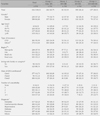Abstract
Purpose
Methods
Results
Figures and Tables
Table 1

LTCI=Long-term care insurance; HN=home nursing; HB=home bathing; HC=home care.
†Others mean national medical aid and low income blanket. The persons in low income blanket were beneficiaries having a subsidy regularly from Korean government; ‡The region is classified according to the administrative district and region's population size. Small city means locations mixed urban area and rural area; §Persons in class 1 have worse functional conditions than class 3; ∥Sample size varies because participants of study have several diseases. The percentage means number of persons in each group among persons with the disease.
*p<.05.
Table 2

HN=home nursing; HB=home bathing; HC=home care.
†This value is number and percentage of fully dependent activity. Score range of activity of daily living items is 13~39. The higher score means worse conditions; ‡Score range of musculoskeletal conditions is 10~30. The higher score means worse conditions.
*p<.05.
Table 3

HN=home nursing; HB=home bathing; HC=home care.
†Sample size varies because participants of study have several diseases. The percentage is calculated as persons with the disease in each group is divided number of persons having each care; ‡Total score of nursing care needs is calculated as number of persons have nursing care needs. Score range is 0~10, The higher score means more nursing care needs(M±SD); §This is included tracheostomy care, suction, oxygen therapy, tube feeding, pain control, colostomy care and dialysis care.
*p<.05.
Table 4

LTCI=Long-term care insurance; HN=home nursing; HB=home bathing; HC=home care.
†This means expenditure for each nursing care per month; ‡This is calculated as paid money for home nursing divided total charge; §This is included tracheostomy care, suction, oxygen therapy, tube feeding, pain control, colostomy care and dialysis care.




 PDF
PDF ePub
ePub Citation
Citation Print
Print


 XML Download
XML Download